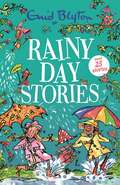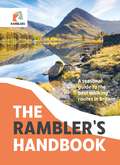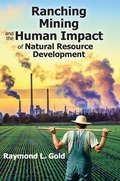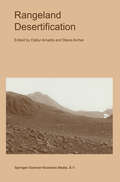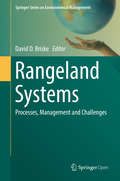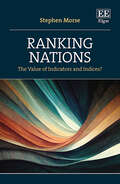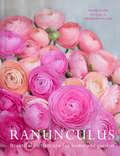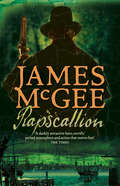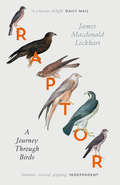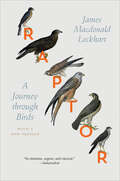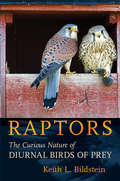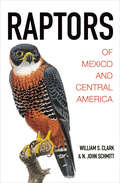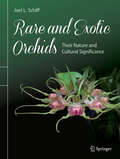- Table View
- List View
Rainy Day Stories: Rainy Day Stories (Bumper Short Story Colle Ser.)
by Enid BlytonPull on your welly boots for these short stories by the world's best-loved story teller. Ideal for children aged 5 and up!In this charming collection by Enid Blyton, children stumble upon secret rooms on rainy days and gnomes pretend they can forecast the weather. The rain may be pouring down in these stories, but there's plenty of mischief and adventure to be found. These classic tales are ideal for younger children being read to and for newly confident readers to read alone. Each story stands alone and is the perfect length for reading at bedtime or in the classroom. Enid Blyton remains one of Britain's favourite children's authors and her bumper short story collections are perfect for introducing her to the latest generation of readers. Read all of Enid Blyton's bumper short story collections. New in 2021: Rainy Day StoriesPet StoriesStories of Spells and EnchantmentsChristmas Tales *** Enid Blyton® and Enid Blyton's signature are registered trade marks of Hodder & Stoughton Limited. No trade mark or copyrighted material may be reproduced without the express written permission of the trade mark and copyright owner.
Raising Elijah: Protecting Our Children in an Age of Environmental Crisis (A Merloyd Lawrence Book)
by Sandra SteingraberNothing could be more important than the health of our children, and no one is better suited to examine the threats against it than Sandra Steingraber. Once called "a poet with a knife," she blends precise science with lyrical memoir. In Living Downstream she spoke as a biologist and cancer survivor; in Having Faith she spoke as an ecologist and expectant mother, viewing her own body as a habitat. Now she speaks as the scientist mother of two young children, enjoying and celebrating their lives while searching for ways to protect them--and all children--from the toxic, climate-threatened world they inhabit Each chapter of this engaging and unique book focuses on one inevitable ingredient of childhood--everything from pizza to laundry to homework to the "Big Talk"--and explores the underlying social, political, and ecological forces behind it. Through these everyday moments, Steingraber demonstrates how closely the private, intimate world of parenting connects to the public world of policy-making and how the ongoing environmental crisis is, fundamentally, a crisis of family life.
The Rambler's Handbook: A Seasonal Guide to the Best Walking Routes in Britain
by The Ramblers' AssociationDiscover the best of Britain's rambles, all year round.Britain is brimming with stunning walks, and this go-to guide sets out our 40 favourite routes around the UK. Arranged by season, each walk includes detailed route instructions, a map, and notes about landmarks and wildlife to keep an eye out for.Amble through bluebell-carpeted West Country woodlands in spring, and explore North Yorkshire's limestone slopes ablaze with wildflowers in early summer. Experience the fiery autumnal hues of the Wye Valley forest, or take a winter walk to see the fallow deer in Richmond Park.We've included a beautiful selection of varied walks all over the UK, from short country strolls to challenging hill hikes, gentle woodland wanders to breathtaking cliff-path adventures, there are routes to cater for all levels of fitness and experience.So, pack your bag, grab your boots and join us for a ramble around our beautiful landscape.
Rambunctious Garden: Saving Nature in a Post-Wild World
by Emma Marris“Remarkable . . . Emma Marris explores a paradox that is increasingly vexing the science of ecology, namely that the only way to have a pristine wilderness is to manage it intensively.” -The Wall Street JournalA paradigm shift is roiling the environmental world. For decades people have unquestioningly accepted the idea that our goal is to preserve nature in its pristine, pre-human state. But many scientists have come to see this as an outdated dream that thwarts bold new plans to save the environment and prevents us from having a fuller relationship with nature. Humans have changed the landscapes they inhabit since prehistory, and climate change means even the remotest places now bear the fingerprints of humanity. Emma Marris argues convincingly that it is time to look forward and create the "rambunctious garden," a hybrid of wild nature and human management.In this optimistic book, readers meet leading scientists and environmentalists and visit imaginary Edens, designer ecosystems, and Pleistocene parks. Marris describes innovative conservation approaches, including rewilding, assisted migration, and the embrace of so-called novel ecosystems.Rambunctious Garden is short on gloom and long on interesting theories and fascinating narratives, all of which bring home the idea that we must give up our romantic notions of pristine wilderness and replace them with the concept of a global, half-wild rambunctious garden planet, tended by us.
Ranaviruses: Lethal Pathogens of Ectothermic Vertebrates
by Matthew J. Gray V. Gregory ChincharThis is the first book on ranaviruses. Ranaviruses are double-stranded DNA viruses that cause hemorrhagic disease in amphibians, reptiles, and fish. They have caused mass die-offs of ectothermic vertebrates in wild and captive populations around the globe. There is evidence that this pathogen is emerging and responsible for population declines in certain locations. Considering that amphibians and freshwater turtles are suitable hosts and the most imperiled vertebrate taxa in the world, ranaviruses can have significant impacts on biodiversity and ecosystem function. Additionally, many fish that are raised in aquaculture facilities and traded internationally are suitable hosts; thus, the potential economic impact of ranaviruses is significant. Ranaviruses also serve as a model for replication and gene function of large double-stranded DNA viruses. There is an urgent need to assemble the contemporary information on ranaviruses and provide guidance on how to assess their threats in populations. Through the Global Ranavirus Consortium, 24 experts from six countries were organize to write this volume, the first book on ranaviruses. The book begins with a discussion on the global extent of ranaviruses, case histories of infection and disease in ectothermic vertebrates, and current phylogeny. Basic principles of ranavirus ecology and evolution are covered next, with a focus on host-pathogen interactions and how the virus emerges in its environment. There are two chapters that will discuss the molecular biology of ranaviruses, host response to infection, and the genes responsible for immune system evasion. One chapter establishes standards for testing for infection and diagnosing ranaviral disease. The book ends by providing guidance on how to design ranavirus surveillance studies and analyze data to determine risk, and discussing the role of the Global Ranavirus Consortium in organizing research and outreach activities.
Ranching, Mining, and the Human Impact of Natural Resource Development
by Raymond L. GoldIn Ranching, Mining, and the Human Impact of Natural Resource Development, Raymond L. Gold observes and reports on people whose lives have been significantly affected by the industrialization of rural communities in the American West. Such community change research is rarely done, so this classic study is invaluable for its real world groundings applicable to a variety of social science theories. The study evolved out of ethnographic research on Western communities done over a full decade.This was the first work of its kind to examine and account for the rise of local citizens' groups on the sense of being a community. Its account of this process covers both ordinarily slow and extraordinarily rapid areas of change in the American West. In this regard it is a contribution to basic social theory, showing clearly the interrelation between small-community and large-society elements of the structure and functioning of community life. No other book brings together the story of social effects of natural resource development projects in the American West.This book shows how to implement a social policy concerning resource development and public agencies. It is intended for people interested in the environment, American society, rural and urban affairs, social impact assessment, and urban structures generally. It is also aimed at industrial and community planners and natural resource development firms.
Ranching, Mining, and the Human Impact of Natural Resource Development
by Raymond L. GoldIn Ranching, Mining, and the Human Impact of Natural Resource Development, Raymond L. Gold observes and reports on people whose lives have been significantly affected by the industrialization of rural communities in the American West. Such community change research is rarely done, so this classic study is invaluable for its real world groundings applicable to a variety of social science theories. The study evolved out of ethnographic research on Western communities done over a full decade.This was the first work of its kind to examine and account for the rise of local citizens' groups on the sense of being a community. Its account of this process covers both ordinarily slow and extraordinarily rapid areas of change in the American West. In this regard it is a contribution to basic social theory, showing clearly the interrelation between small-community and large-society elements of the structure and functioning of community life. No other book brings together the story of social effects of natural resource development projects in the American West.This book shows how to implement a social policy concerning resource development and public agencies. It is intended for people interested in the environment, American society, rural and urban affairs, social impact assessment, and urban structures generally. It is also aimed at industrial and community planners and natural resource development firms.
Rangeland Desertification (Advances in Vegetation Science #19)
by Olafur ArnaldsDesertification has occurred worldwide. The biophysical and socio-economic complexity of this phenomenon has challenged our ability to categorize, inventory, monitor and repair the condition of degraded lands. One of the most important distinctions to be made in relation to land degradation is between cultivated land used for annual crop production and `rangelands'. Grazing by free-roaming livestock is the traditional primary use of the world's rangelands. However, there is growing recognition of the importance of these vast acreages for wildlife habitat, hydrology and ground water recharge, recreation and aesthetics. This text focuses on the desertification of rangelands and explores processes, problems and solutions. Chapters in the first section evaluate interactions between `natural' and human-induced disturbance regimes, thresholds, and non-linear change with respect to vegetation, hydrology, nutrients and erosion. Chapters in the second section examine socio-economic constraints and approaches for preventing and reversing degradation. The book provides a contemporary, process-oriented perspective on rangeland degradation of value to students, policy-makers and professionals alike.
Rangeland Systems: Processes, Management and Challenges (Springer Series on Environmental Management)
by David D. BriskeThis book is open access under a CC BY-NC 2.5 license.This book provides an unprecedented synthesis of the current status of scientific and management knowledge regarding global rangelands and the major challenges that confront them. It has been organized around three major themes. The first summarizes the conceptual advances that have occurred in the rangeland profession. The second addresses the implications of these conceptual advances to management and policy. The third assesses several major challenges confronting global rangelands in the 21st century. This book will compliment applied range management textbooks by describing the conceptual foundation on which the rangeland profession is based. It has been written to be accessible to a broad audience, including ecosystem managers, educators, students and policy makers. The content is founded on the collective experience, knowledge and commitment of 80 authors who have worked in rangelands throughout the world. Their collective contributions indicate that a more comprehensive framework is necessary to address the complex challenges confronting global rangelands. Rangelands represent adaptive social-ecological systems, in which societal values, organizations and capacities are of equal importance to, and interact with, those of ecological processes. A more comprehensive framework for rangeland systems may enable management agencies, and educational, research and policy making organizations to more effectively assess complex problems and develop appropriate solutions.
Rangeland Wildlife Ecology and Conservation
by Lance B. McNew David K. Dahlgren Jeffrey L. BeckThis open access book reviews the importance of ecological functioning within rangelands considering the complex inter-relationships of production agriculture, ecosystem services, biodiversity, and wildlife habitat. More than half of all lands worldwide, and up to 70% of the western USA, are classified as rangelands—uncultivated lands that often support grazing by domestic livestock. The rangelands of North America provide a vast array of goods and services, including significant economic benefit to local communities, while providing critical habitat for hundreds of species of fish and wildlife. This book provides compendium of recent data and synthesis from more than 100 experts in wildlife and rangeland ecology in Western North America. It provides a current and in-depth synthesis of knowledge related to wildlife ecology in rangeland ecosystems, and the tools used to manage them, to serve current and future wildlife biologists and rangeland managers in the working landscapes of the West. The book also identifies information gaps and serves as a jumping-off point for future research of wildlife in rangeland ecosystems. While the content focuses on wildlife ecology and management in rangelands of Western North America, the material has important implications for rangeland ecosystems worldwide.
Ranking Nations: The Value of Indicators and Indices?
by Stephen MorseThis engaging book assesses the statistical need for using particular ranking systems to compare the status of nations. With an overarching focus on human development, environmental performance and corruption, it carefully maps out some of the main processes associated with the ranking of countries.Centrally, Stephen Morse explores challenges associated with using index-based rankings for countries. Examining international ranking systems such as the Human Development Index and Corruption Perception Index, the book considers what they tell us about the world and whether there may be alternatives to these ranking techniques. It provides an important contemporary view on ranking systems by analysing not only how they are reported by traditional sources of media, but also by social media.Ranking Nations will be a significant read for economics, development studies and human geography researchers and academics. Its accessible written style will also benefit policy actors and decision makers that make use of index-based rankings.
Ranunculus: Beautiful Buttercups For Home And Garden
by Naomi SladeRanunculus offers advice on how to care for and propagate these colourful cultivated members of the buttercup family. Naomi Slade explores a wide range of ranunculus species and cultivars, all beautifully photographed by Georgianna Lane in their technicolour glory from palest pink to deep burgundy via white, orange, red and yellow.
Rapscallion: A Regency Crime Thriller (The\hawkwood Mysteries Ser. #3)
by James McGeeMatthew Hawkwood, ex-soldier turned Bow Street Runner, goes undercover to hunt down smugglers and traitors at the height of the Napoleonic Wars in this thrilling follow-up to Ratcatcher.
Raptor: A Journey Through Birds
by James Macdonald LockhartWinner of The Royal Society of Literature Jerwood Award for Non-Fiction in 2011 and the Authors' Foundation Roger Deakin Award in 2011 A stunning debut in the tradition of Robert Macfarlane and Helen Macdonald
Raptor: A Journey through Birds
by James Macdonald LockhartFrom the merlin to the golden eagle, the goshawk to the honey buzzard, James Macdonald Lockhart’s stunning debut is a quest of beak, talon, wing, and sky. On its surface, Raptor is a journey across the British Isles in search of fifteen species of birds of prey, but as Lockhart seeks out these elusive predators, his quest becomes so much more: an incomparably elegant elegy on the beauty of the British landscape and, through the birds, a journey toward understanding an awesome power at the heart of the natural world—a power that is majestic and frightening in its strength, but also fragile. Taking as his guide the nineteenth-century Scottish naturalist and artist William MacGillivray, Lockhart loosely follows the historical trail forged by MacGillivray as he ventured from Aberdeen to London filling his pockets with plants and writing and illustrating the canonical A History of British Birds. Linking his journey to that of his muse, Lockhart shares his own encounters with raptors ranging from the scarce osprey to the successfully reintroduced red kite, a species once protected by medieval royal statute, revealing with poetic immediacy the extraordinary behaviors of these birds and the extreme environments they call home. Creatures both worshipped and reviled, raptors have a talon-hold on the human heart and imagination. With his book, Lockhart unravels these complicated ties in a work by turns reverent and euphoric—an interweaving of history, travel, and nature writing at its best. A hymn to wanderers, to the land and to the sky, and especially to the birds, Raptor soars.
Raptor: A Journey through Birds
by James Macdonald LockhartFrom the merlin to the golden eagle, the goshawk to the honey buzzard, James Macdonald Lockhart’s stunning debut is a quest of beak, talon, wing, and sky. On its surface, Raptor is a journey across the British Isles in search of fifteen species of birds of prey, but as Lockhart seeks out these elusive predators, his quest becomes so much more: an incomparably elegant elegy on the beauty of the British landscape and, through the birds, a journey toward understanding an awesome power at the heart of the natural world—a power that is majestic and frightening in its strength, but also fragile. Taking as his guide the nineteenth-century Scottish naturalist and artist William MacGillivray, Lockhart loosely follows the historical trail forged by MacGillivray as he ventured from Aberdeen to London filling his pockets with plants and writing and illustrating the canonical A History of British Birds. Linking his journey to that of his muse, Lockhart shares his own encounters with raptors ranging from the scarce osprey to the successfully reintroduced red kite, a species once protected by medieval royal statute, revealing with poetic immediacy the extraordinary behaviors of these birds and the extreme environments they call home. Creatures both worshipped and reviled, raptors have a talon-hold on the human heart and imagination. With his book, Lockhart unravels these complicated ties in a work by turns reverent and euphoric—an interweaving of history, travel, and nature writing at its best. A hymn to wanderers, to the land and to the sky, and especially to the birds, Raptor soars.
Raptor: A Journey through Birds
by James Macdonald LockhartFrom the merlin to the golden eagle, the goshawk to the honey buzzard, James Macdonald Lockhart’s stunning debut is a quest of beak, talon, wing, and sky. On its surface, Raptor is a journey across the British Isles in search of fifteen species of birds of prey, but as Lockhart seeks out these elusive predators, his quest becomes so much more: an incomparably elegant elegy on the beauty of the British landscape and, through the birds, a journey toward understanding an awesome power at the heart of the natural world—a power that is majestic and frightening in its strength, but also fragile. Taking as his guide the nineteenth-century Scottish naturalist and artist William MacGillivray, Lockhart loosely follows the historical trail forged by MacGillivray as he ventured from Aberdeen to London filling his pockets with plants and writing and illustrating the canonical A History of British Birds. Linking his journey to that of his muse, Lockhart shares his own encounters with raptors ranging from the scarce osprey to the successfully reintroduced red kite, a species once protected by medieval royal statute, revealing with poetic immediacy the extraordinary behaviors of these birds and the extreme environments they call home. Creatures both worshipped and reviled, raptors have a talon-hold on the human heart and imagination. With his book, Lockhart unravels these complicated ties in a work by turns reverent and euphoric—an interweaving of history, travel, and nature writing at its best. A hymn to wanderers, to the land and to the sky, and especially to the birds, Raptor soars.
Raptor: A Journey through Birds
by James Macdonald LockhartFrom the merlin to the golden eagle, the goshawk to the honey buzzard, James Macdonald Lockhart’s stunning debut is a quest of beak, talon, wing, and sky. On its surface, Raptor is a journey across the British Isles in search of fifteen species of birds of prey, but as Lockhart seeks out these elusive predators, his quest becomes so much more: an incomparably elegant elegy on the beauty of the British landscape and, through the birds, a journey toward understanding an awesome power at the heart of the natural world—a power that is majestic and frightening in its strength, but also fragile. Taking as his guide the nineteenth-century Scottish naturalist and artist William MacGillivray, Lockhart loosely follows the historical trail forged by MacGillivray as he ventured from Aberdeen to London filling his pockets with plants and writing and illustrating the canonical A History of British Birds. Linking his journey to that of his muse, Lockhart shares his own encounters with raptors ranging from the scarce osprey to the successfully reintroduced red kite, a species once protected by medieval royal statute, revealing with poetic immediacy the extraordinary behaviors of these birds and the extreme environments they call home. Creatures both worshipped and reviled, raptors have a talon-hold on the human heart and imagination. With his book, Lockhart unravels these complicated ties in a work by turns reverent and euphoric—an interweaving of history, travel, and nature writing at its best. A hymn to wanderers, to the land and to the sky, and especially to the birds, Raptor soars.
Raptors: The Curious Nature of Diurnal Birds of Prey
by Keith L. BildsteinRaptors are formally classified into five families and include birds—such as eagles, ospreys, kites, true hawks, buzzards, harriers, vultures, and falcons—that are familiar and recognized by many observers. These diurnal birds of prey are found on every continent except Antarctica and can thrive in seemingly inhospitable spots such as deserts and the tundra. They have powerful talons and hooked beaks for cutting and tearing meat, and keen binocular vision to aid in their hunting prowess. Because of their large size, distinctive feeding habits, and long-distance flight patterns, raptors intrigue humans and have been the subject of much general interest as well as extensive scientific research. Keith L. Bildstein has watched and studied raptors on five continents and is well prepared to explain their critical importance, not only as ecological entities but also as inspirational tokens across natural and human-dominated landscapes. His book offers a comprehensive and accessible account of raptors, including their evolutionary history, their relationships to other groups of birds, their sensory abilities, their general natural history, their breeding ecology and feeding behavior, and threats to their survival in a human-dominated world. Biologically sound but readable, Raptors is a nontechnical overview of this captivating group. It will allow naturalists, birders, hawk-watchers, science educators, schoolchildren, and the general public, along with new students in the field of raptor biology, to understand and appreciate these birds, and in so doing better protect them.
Raptors of Mexico and Central America
by William S. Clark N. John Schmitt Lloyd KiffThe essential field guide to the raptors of Mexico and Central AmericaRaptors are among the most challenging birds to identify in the field due to their bewildering variability of plumage, flight silhouettes, and behavior. Raptors of Mexico and Central America is the first illustrated guide to the region's 69 species of raptors, including vagrants. It features 32 stunning color plates and 213 color photos, and a distribution map for each regularly occurring species. Detailed species accounts describe key identification features, age-related plumages, status and distribution, subspecies, molt, habitats, behaviors, potential confusion species, and more.Raptors of Mexico and Central America is the essential field guide to this difficult bird group and the ideal travel companion for anyone visiting this region of the world.Covers all 69 species of raptors found in Mexico and Central AmericaFeatures 32 color plates and hundreds of color photosProvides multiple illustrations of each speciesDepicts and describes variations in plumage by individual, morph, age, and regionDescribes behavior, food preferences, hunting strategies, vocalizations, and moltCovers rare and extralimital speciesIncludes distribution maps and flight silhouettes
Raptors of Mexico and Central America
by William S. Clark N. John Schmitt Lloyd KiffThe essential field guide to the raptors of Mexico and Central AmericaRaptors are among the most challenging birds to identify in the field due to their bewildering variability of plumage, flight silhouettes, and behavior. Raptors of Mexico and Central America is the first illustrated guide to the region's 69 species of raptors, including vagrants. It features 32 stunning color plates and 213 color photos, and a distribution map for each regularly occurring species. Detailed species accounts describe key identification features, age-related plumages, status and distribution, subspecies, molt, habitats, behaviors, potential confusion species, and more.Raptors of Mexico and Central America is the essential field guide to this difficult bird group and the ideal travel companion for anyone visiting this region of the world.Covers all 69 species of raptors found in Mexico and Central AmericaFeatures 32 color plates and hundreds of color photosProvides multiple illustrations of each speciesDepicts and describes variations in plumage by individual, morph, age, and regionDescribes behavior, food preferences, hunting strategies, vocalizations, and moltCovers rare and extralimital speciesIncludes distribution maps and flight silhouettes
Rare and Exotic Orchids: Their Nature and Cultural Significance
by Joel L. SchiffComprising some 28,000 different species, orchids are by far the largest flowering plant family on Earth. Every year, new species are being uncovered in the wild or created by humans, and so this number has only continued to blossom. This book is intended for those who wish to learn about the multifaceted nature of this amazing plant. It covers many different aspects of orchid study, from its cultural history to its evolutionary development and from its first discoveries to ongoing scientific research. No matter your specialty or level of orchid expertise, you can find in this book new and fascinating facts and stories that will make you gasp, laugh, and read on. Through the many exotic and beautiful pictures permeating these pages, you will come to know something of the infinite diversity of this plant family and at last learn why so many orchid growers and fanatics have embarked on this same endless path.“I was smitten with this book after reading the very first chapter on the history of Orchids...There are plenty of interesting facts to charm your orchid friends and impress even the most studied researcher… All in all a fabulous read that is well illustrated and with a reference section the likes of which I have never seen before with its vast and varied appendices on a slew of subjects. If you are looking for a book that is engaging and educational with lots of good humor thrown in, then this book is for you. I know that I will treasure my copy for years to come.” -- Laura Newton, American Orchid Society Awards Registrar and Accredited Judge, ORCHIDS Magazine (May, 2018)"Joel L. Schiff brings to life not just the science surrounding orchids, but the human process of recognizing, cataloging, and appreciating them...It's this approach, combined with lovely close-up color photos throughout, which makes Rare and Exotic Orchids a recommendation not just for professionals or botany libraries, but for general-interest readers who will enjoy a highly accessible study that invites an in-depth interest in orchids and their importance to human affairs."-- Diane Donovan’s Pick of the Month (April, 2018)
Rare Birds in Britain and Ireland (Poyser Monographs)
by J. N Dymond P. A Fraser S.J.M GantlettThis book by a trio of rare-bird specialists is a successor to two earlier works (long out of print), Scarce Migrant Birds in Britain and Ireland (Sharrock 1974 and Rare Birds in Britain and Ireland (Sharrock 1976). It unifies both of the earlier books and updates them, adding more than 80 species to the previous total.The authors have analysed and considered some 45,000 records of scarce and rare birds in Britain and Ireland for the period 1958-85. Extreme rarities outside the period are also listed. They have produced not only a book of great fascination for those who delight in rarities for their own sake, but one that offers valuable information on changing patterns of arrival which may indicate changes of status of these birds within their breeding range.More than 300 species accounts are now included, most of them accompanied by histograms of weekly and seasonal occurrences, with maps showing distribution by counties in spring and autumn or at particular times of the year. For rarities with twelve or fewer occurrences during the period 1958-85, the place, date and other relevant information is given for each record.Every species is illustrated by a line drawing, more than 150 of them commissioned for this book, the remainder being selected from the two earlier works.
Rare Birds in Britain and Ireland: (1989) (Poyser Monographs #125)
by J.N Dymond P.A Fraser S.J.M GantlettThis book by a trio of rare-bird specialists is a successor to two earlier works (long out of print), Scarce Migrant Birds in Britain and Ireland (Sharrock 1974 and Rare Birds in Britain and Ireland (Sharrock 1976). It unifies both of the earlier books and updates them, adding more than 80 species to the previous total.The authors have analysed and considered some 45,000 records of scarce and rare birds in Britain and Ireland for the period 1958-85. Extreme rarities outside the period are also listed. They have produced not only a book of great fascination for those who delight in rarities for their own sake, but one that offers valuable information on changing patterns of arrival which may indicate changes of status of these birds within their breeding range.More than 300 species accounts are now included, most of them accompanied by histograms of weekly and seasonal occurrences, with maps showing distribution by counties in spring and autumn or at particular times of the year. For rarities with twelve or fewer occurrences during the period 1958-85, the place, date and other relevant information is given for each record.Every species is illustrated by a line drawing, more than 150 of them commissioned for this book, the remainder being selected from the two earlier works.
Rare Birds in Britain and Ireland: (1976) (Poyser Monographs)
by J.T.R. Sharrock E. M SharrockDr J. T. R. Sharrock is uniquely placed to write about the rare birds of Britain and Ireland. He is a member of all three bodies which adjudicate on such records - honorary secretary of the British Ornithologists' Union's Records Committee and a member of both the British Birds Rarities Committee and the Irish Records Panel. He is already the author of a companion book which deals with a selection of the commoner rarities, Scarce Migrant Birds in Britain and Ireland (see back of this jacket for details). In this new, much fuller book the enormous task of collation of over 8000 records and their visual display as maps and histograms was carried out by Mrs E. M. Sharrock. The textual and visual analysis deals with 221 different species. Between them, the authors present a complete picture of rare birds in Britain and Ireland: * HOW MANY are seen? * WHEN do they occur? * HOW regularly do they come? * WHERE are they seen? There are line drawings of all 221 species by well-known bird artists: Robert Gillmor, P. J. Grant, R. A. Richardson, D. I. M. Wallace and lan Willis. Jacket design by Robert Gillmor
